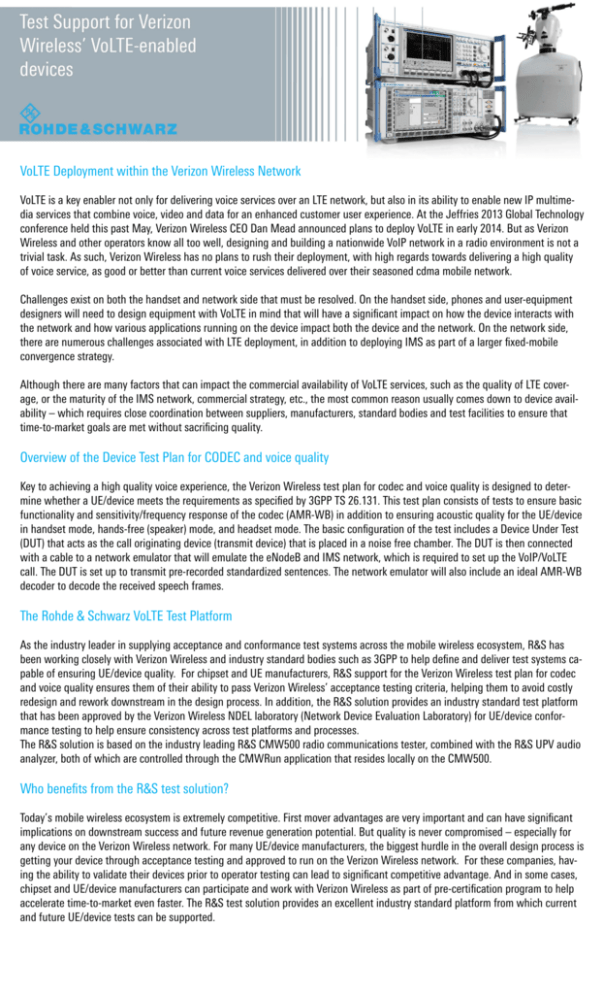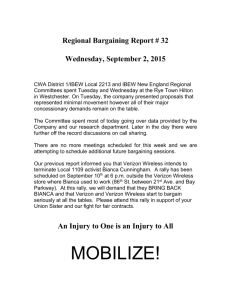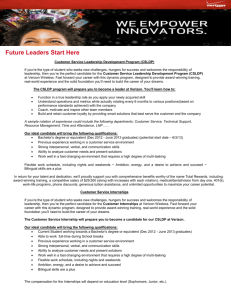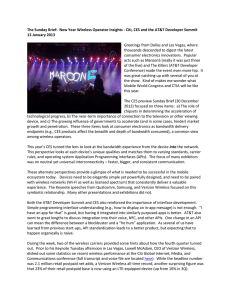VoLTE Deployment within the Verizon Wireless Network Overview of
advertisement

VoLTE Deployment within the Verizon Wireless Network VoLTE is a key enabler not only for delivering voice services over an LTE network, but also in its ability to enable new IP multimedia services that combine voice, video and data for an enhanced customer user experience. At the Jeffries 2013 Global Technology conference held this past May, Verizon Wireless CEO Dan Mead announced plans to deploy VoLTE in early 2014. But as Verizon Wireless and other operators know all too well, designing and building a nationwide VoIP network in a radio environment is not a trivial task. As such, Verizon Wireless has no plans to rush their deployment, with high regards towards delivering a high quality of voice service, as good or better than current voice services delivered over their seasoned cdma mobile network. Challenges exist on both the handset and network side that must be resolved. On the handset side, phones and user-equipment designers will need to design equipment with VoLTE in mind that will have a significant impact on how the device interacts with the network and how various applications running on the device impact both the device and the network. On the network side, there are numerous challenges associated with LTE deployment, in addition to deploying IMS as part of a larger fixed-mobile convergence strategy. Although there are many factors that can impact the commercial availability of VoLTE services, such as the quality of LTE coverage, or the maturity of the IMS network, commercial strategy, etc., the most common reason usually comes down to device availability – which requires close coordination between suppliers, manufacturers, standard bodies and test facilities to ensure that time-to-market goals are met without sacrificing quality. Overview of the Device Test Plan for CODEC and voice quality Key to achieving a high quality voice experience, the Verizon Wireless test plan for codec and voice quality is designed to determine whether a UE/device meets the requirements as specified by 3GPP TS 26.131. This test plan consists of tests to ensure basic functionality and sensitivity/frequency response of the codec (AMR-WB) in addition to ensuring acoustic quality for the UE/device in handset mode, hands-free (speaker) mode, and headset mode. The basic configuration of the test includes a Device Under Test (DUT) that acts as the call originating device (transmit device) that is placed in a noise free chamber. The DUT is then connected with a cable to a network emulator that will emulate the eNodeB and IMS network, which is required to set up the VoIP/VoLTE call. The DUT is set up to transmit pre-recorded standardized sentences. The network emulator will also include an ideal AMR-WB decoder to decode the received speech frames. The Rohde & Schwarz VoLTE Test Platform As the industry leader in supplying acceptance and conformance test systems across the mobile wireless ecosystem, R&S has been working closely with Verizon Wireless and industry standard bodies such as 3GPP to help define and deliver test systems capable of ensuring UE/device quality. For chipset and UE manufacturers, R&S support for the Verizon Wireless test plan for codec and voice quality ensures them of their ability to pass Verizon Wireless’ acceptance testing criteria, helping them to avoid costly redesign and rework downstream in the design process. In addition, the R&S solution provides an industry standard test platform that has been approved by the Verizon Wireless NDEL laboratory (Network Device Evaluation Laboratory) for UE/device conformance testing to help ensure consistency across test platforms and processes. The R&S solution is based on the industry leading R&S CMW500 radio communications tester, combined with the R&S UPV audio analyzer, both of which are controlled through the CMWRun application that resides locally on the CMW500. Who benefits from the R&S test solution? Today’s mobile wireless ecosystem is extremely competitive. First mover advantages are very important and can have significant implications on downstream success and future revenue generation potential. But quality is never compromised – especially for any device on the Verizon Wireless network. For many UE/device manufacturers, the biggest hurdle in the overall design process is getting your device through acceptance testing and approved to run on the Verizon Wireless network. For these companies, having the ability to validate their devices prior to operator testing can lead to significant competitive advantage. And in some cases, chipset and UE/device manufacturers can participate and work with Verizon Wireless as part of pre-certification program to help accelerate time-to-market even faster. The R&S test solution provides an excellent industry standard platform from which current and future UE/device tests can be supported.











